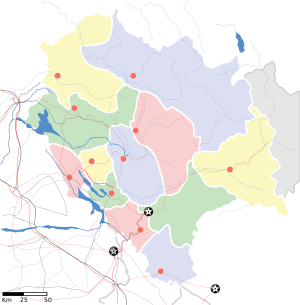Dalhousie, India
| Dalhousie | |
|---|---|
| Hill station | |
 Dalhousie  Dalhousie | |
| Coordinates: 32°32′N 75°59′E / 32.53°N 75.98°ECoordinates: 32°32′N 75°59′E / 32.53°N 75.98°E | |
| Country | India |
| State | Himachal Pradesh |
| District | Chamba |
| Elevation | 1,970 m (6,460 ft) |
| Population (2011) | |
| • Total | 7,051 |
| • Rank | 25 in HP |
| Time zone | UTC+5:30 (IST) |
| PIN | 176304 |
| Telephone code | +91 1899 |
| Vehicle registration | HP-47 |
Dalhousie is a hill station in Chamba district, in the northern Indian state of Himachal Pradesh. It is situated on 5 hills and has an elevation of 1,970 metres above sea level.[1]
Etymology
Dalhousie Town was named after The Earl of Dalhousie, who was the British Governor-General in India while establishing this place as a summer retreat.[2]
History
Dalhousie is a hill station in Himachal Pradesh, established in 1854 by the British Empire's government in British India as a summer retreat for its troops and officials after annexation of the Sikh Empire, Punjab.It is built on and around five hills, Kathalagh, Potreyn, Terah, Bakrota and Bhangora.[2] Located on the western edge of the Dhauladhar mountain range of the Himalayas, it is surrounded by snow-capped peaks. Dalhousie is situated between 6,000 and 9,000 feet (2,700 m) above sea level. It was established on the land of the Sikh Empire Punjab after being annexed by British. Dalhousie remained part of Punjab until 1966, when it was excised from Punjab by the Punjab Reorganisation Act, 1966.
The best time to visit is in the summer, and the peak tourist season is from May to September. Scottish and Victorian architecture is prevalent in the bungalows and churches in the town. Dalhousie is a gateway to the ancient Chamba Hill State, now Chamba District of the state of Himachal Pradesh of India. This hill region is a repository of ancient Hindu culture, art, temples, and handicrafts preserved under the longest-running single dynasty since the mid-6th century. Chamba is the hub of this culture. Bharmour, the ancient capital of this kingdom, is home to the Gaddi and Gujjar tribes. It has 84 ancient temples dating from the 7th–10th centuries AD.
Climate
Dalhousie has a humid subtropical climate (Cwa). Late summer and early spring see torrential rainfall due to monsoonal influence. The city sees over 45 frost days per year and 2-3 snow days.
| Climate data for Dalhousie | |||||||||||||
|---|---|---|---|---|---|---|---|---|---|---|---|---|---|
| Month | Jan | Feb | Mar | Apr | May | Jun | Jul | Aug | Sep | Oct | Nov | Dec | Year |
| Average high °C (°F) | 9.8 (49.6) |
12.4 (54.3) |
16.7 (62.1) |
21.8 (71.2) |
25.2 (77.4) |
27.4 (81.3) |
23.6 (74.5) |
22.6 (72.7) |
22.7 (72.9) |
20.9 (69.6) |
17.5 (63.5) |
13.9 (57) |
19.5 (67.2) |
| Average low °C (°F) | 1.2 (34.2) |
3.1 (37.6) |
7.1 (44.8) |
11.2 (52.2) |
15.2 (59.4) |
17.6 (63.7) |
16.5 (61.7) |
16.2 (61.2) |
14.9 (58.8) |
11.0 (51.8) |
7.0 (44.6) |
4.2 (39.6) |
10.4 (50.8) |
| Average precipitation mm (inches) | 178 (7.01) |
145 (5.71) |
147 (5.79) |
83 (3.27) |
71 (2.8) |
109 (4.29) |
537 (21.14) |
543 (21.38) |
255 (10.04) |
70 (2.76) |
23 (0.91) |
76 (2.99) |
2,237 (88.09) |
| Average precipitation days | 12.4 | 15.8 | 10.2 | 16.8 | 15.0 | 13.2 | 20.8 | 21.5 | 11.4 | 5.5 | 4.6 | 8.3 | 155.5 |
| Source: [3] | |||||||||||||
References
- ↑ Gopal, Madan (1990). K.S. Gautam, ed. India through the ages. Publication Division, Ministry of Information and Broadcasting, Government of India. p. 177.
- 1 2 "Dalhousie: perfect summer getaway". Bangalore Mirror. 4 March 2010. Archived from the original on 6 March 2010.
- ↑ "CLIMATE: DALHOUSIE". Climate-Data. Retrieved 31 March 2017.
External links
| Wikimedia Commons has media related to Dalhousie, India. |

- More information about Dalhousie.